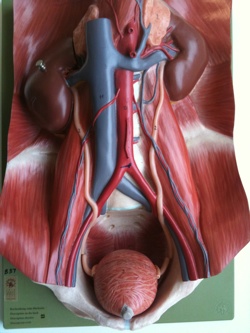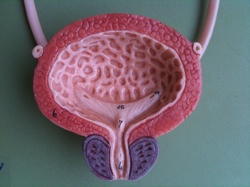 This week we pretty much finished off looking at the renal system by looking at the bladder (we only have the male urethra yet to study).
This week we pretty much finished off looking at the renal system by looking at the bladder (we only have the male urethra yet to study).
We used visiblebody.com to get an idea of where the bladder is (and that it is anterior within the pelvis, right up against the pubis bones) and the shape of the bladder. Textbooks sometimes describe the bladder as an upside-down pyramid, which kind of fits. Visiblebody.com shows the shape quite well, which is something that’s difficult to get from an image or a prosection. Some of the plastic models in the lab are quite good, and most of the torsos have them.
Remembering that the bladder is the most anterior viscera in the pelvis is helpful. When looking at prosections, particularly of female pelvises, it can get a little confusing. Remembering that the bladder is anterior makes it easy to locate and identify (male: bladder-rectum, female: bladder-vagina-rectum).
The bladder receives urine from the two ureters that enter its posterior wall (also known as the base). The ureters don’t have real sphincters to prevent backflow from the bladder, but they do pass through the detrusor muscle of the bladder at an angle that gives a physiological sphincter.
The bladder is lined with a specialised epithelium called transistional epithelium or urothelium that allows for the stretch of the bladder as it fills and is not too fussed about constantly being in contact with urine. This urothelium lines a layer of detrusor muscle that contracts to squeeze and empty the bladder (so, along with the peristaltic contractions of the ureters this means that you should be able to urinate upside-down, or in space – this isn’t a gravity-fed system). When the detrusor muscle contracts it also squeezes and closes off the ureters.
 The trigone of the bladder describes a triangular area of the bladder seen as a smooth patch internally, between the ureters and the urethra. Here the urothelium is tightly adherent to the detrusor muscle. Elsewhere the inside of the bladder appears folded, much like the rugae that we saw in the stomach.
The trigone of the bladder describes a triangular area of the bladder seen as a smooth patch internally, between the ureters and the urethra. Here the urothelium is tightly adherent to the detrusor muscle. Elsewhere the inside of the bladder appears folded, much like the rugae that we saw in the stomach.
The urothelium and the rugae allow the bladder to stretch to hold maybe 500ml of urine or more. By this point your parasympathetic nervous system may well have triggered the detrusor muscle to squeeze and the internal sphincter muscle to open to try to empty the bladder. Luckily you still have control over the external sphincter (and your levator ani muscle group) so hopefully you can hold on until you find somewhere appropriate to relieve yourself. Before your bladder fills to maximum capacity your micturition control centre in your frontal lobe will hopefully give you a level of control over where and when you choose to empty your bladder (and you can read more about nervous control in this eMedicine article: Neurogenic bladder.
The neck of the bladder is its most fixed part, and we saw in the prosections how mobile the bladder is. It is supported and surrounded by the muscles of the pelvic floor, the obturator internus muscles, the visera of the pelvis, the peritoneum, and the overlying small bowel. In the female pelvis the neck of the bladder is attached to the pubis bones by the pubovesical ligament, and in the male pelvis by the puboprostatic ligament (and as the name implies, the prostate gland directly inferior to the bladder is also fixed in place by this).
You may wish to review the blood supply of the pelvis as a whole (particularly the branches of the anterior trunk of the internal iliac artery) to better understand the arteries that supply the bladder in both male and female pelvises but I won’t go into that here. Maybe take a look at this diagram on Instant Anatomy.